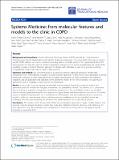| dc.contributor.author | Gomez-Cabrero, David | en_US |
| dc.contributor.author | Menche, Jörg | en_US |
| dc.contributor.author | Cano, Isaac | en_US |
| dc.contributor.author | Abugessaisa, Imad | en_US |
| dc.contributor.author | Huertas-Migueláñez, Mercedes | en_US |
| dc.contributor.author | Tenyi, Akos | en_US |
| dc.contributor.author | de Mas, Igor Marin | en_US |
| dc.contributor.author | Kiani, Narsis A | en_US |
| dc.contributor.author | Marabita, Francesco | en_US |
| dc.contributor.author | Falciani, Francesco | en_US |
| dc.contributor.author | Burrowes, Kelly | en_US |
| dc.contributor.author | Maier, Dieter | en_US |
| dc.contributor.author | Wagner, Peter | en_US |
| dc.contributor.author | Selivanov, Vitaly | en_US |
| dc.contributor.author | Cascante, Marta | en_US |
| dc.contributor.author | Roca, Josep | en_US |
| dc.contributor.author | Barabási, Albert-László | en_US |
| dc.contributor.author | Tegnér, Jesper | en_US |
| dc.date.accessioned | 2015-01-05T18:27:39Z | |
| dc.date.issued | 2014 | en_US |
| dc.identifier.citation | Gomez-Cabrero, D., J. Menche, I. Cano, I. Abugessaisa, M. Huertas-Migueláñez, A. Tenyi, I. M. de Mas, et al. 2014. “Systems Medicine: from molecular features and models to the clinic in COPD.” Journal of Translational Medicine 12 (Suppl 2): S4. doi:10.1186/1479-5876-12-S2-S4. http://dx.doi.org/10.1186/1479-5876-12-S2-S4. | en |
| dc.identifier.issn | 1479-5876 | en |
| dc.identifier.uri | http://nrs.harvard.edu/urn-3:HUL.InstRepos:13581146 | |
| dc.description.abstract | Background and hypothesis Chronic Obstructive Pulmonary Disease (COPD) patients are characterized by heterogeneous clinical manifestations and patterns of disease progression. Two major factors that can be used to identify COPD subtypes are muscle dysfunction/wasting and co-morbidity patterns. We hypothesized that COPD heterogeneity is in part the result of complex interactions between several genes and pathways. We explored the possibility of using a Systems Medicine approach to identify such pathways, as well as to generate predictive computational models that may be used in clinic practice. Objective and method Our overarching goal is to generate clinically applicable predictive models that characterize COPD heterogeneity through a Systems Medicine approach. To this end we have developed a general framework, consisting of three steps/objectives: (1) feature identification, (2) model generation and statistical validation, and (3) application and validation of the predictive models in the clinical scenario. We used muscle dysfunction and co-morbidity as test cases for this framework. Results: In the study of muscle wasting we identified relevant features (genes) by a network analysis and generated predictive models that integrate mechanistic and probabilistic models. This allowed us to characterize muscle wasting as a general de-regulation of pathway interactions. In the co-morbidity analysis we identified relevant features (genes/pathways) by the integration of gene-disease and disease-disease associations. We further present a detailed characterization of co-morbidities in COPD patients that was implemented into a predictive model. In both use cases we were able to achieve predictive modeling but we also identified several key challenges, the most pressing being the validation and implementation into actual clinical practice. Conclusions: The results confirm the potential of the Systems Medicine approach to study complex diseases and generate clinically relevant predictive models. Our study also highlights important obstacles and bottlenecks for such approaches (e.g. data availability and normalization of frameworks among others) and suggests specific proposals to overcome them. | en |
| dc.language.iso | en_US | en |
| dc.publisher | BioMed Central | en |
| dc.relation.isversionof | doi:10.1186/1479-5876-12-S2-S4 | en |
| dc.relation.hasversion | http://www.ncbi.nlm.nih.gov/pmc/articles/PMC4255907/pdf/ | en |
| dash.license | LAA | en_US |
| dc.subject | Chronic diseases | en |
| dc.subject | COPD | en |
| dc.subject | Disease heterogeneity | en |
| dc.subject | Systems Medicine | en |
| dc.subject | Predictive Modeling | en |
| dc.subject | Co-morbidity | en |
| dc.title | Systems Medicine: from molecular features and models to the clinic in COPD | en |
| dc.type | Journal Article | en_US |
| dc.description.version | Version of Record | en |
| dc.relation.journal | Journal of Translational Medicine | en |
| dash.depositing.author | Barabási, Albert-László | en_US |
| dc.date.available | 2015-01-05T18:27:39Z | |
| dc.identifier.doi | 10.1186/1479-5876-12-S2-S4 | * |
| dash.authorsordered | false | |
| dash.contributor.affiliated | Barabasi, Albert-Laszlo | |


